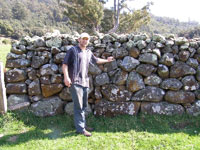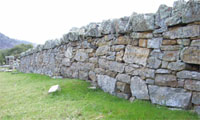

Drystone walls appeared in the rural Tasmanian landscape as soon as the most fertile lands were ploughed and had to be cleared of surface stone. In the north and midlands, the productive red loams over basalt also produced a lot of stone walls(!), some of which remain today. Most lack copes or through-stones, the unrefined technique suggesting they were built by farm labourers rather than wallers. (See first pic right »)
In the south and east, the abundant sandstone was used for both masonry and walls, with the use of cope stones more prevalent (See second pic right »).
Many of the old walls have disappeared from the Tasmanian landscape in the past 50 years. Some have collapsed from neglect or undermining by both rabbit and man during the rabbit plagues of the depression era. Others were crushed to provide bluemetal for road gangs with the introduction of asphalt sealed roads during the 1950's. The modern methods of farming have also aided the demise of stone walls, with many knocked down to widen paddocks for larger machinery or pivot irrigation systems.

In recent years however, there has been a revived interest in drystone walls, with both increased demand for new walls in landscaping and a better appreciation of historical examples. The formation of the Dry Stone Walls Association of Australia in 2002 has helped raise interest and awareness with local councils placing some significant walls onto heritage registers.